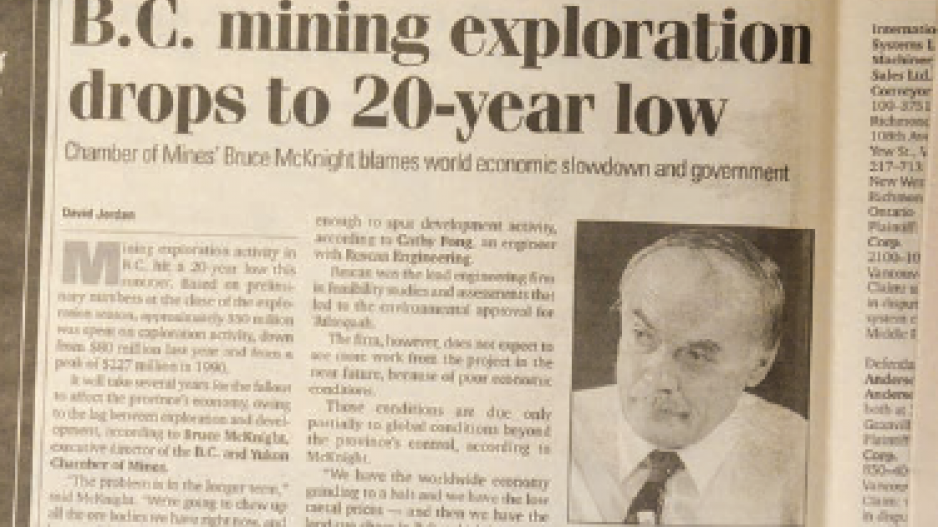July 1993 was a watershed time for mining in B.C.
Mike Harcourt’s NDP government had announced the creation of Tatshenshini-Alsek Provincial Wilderness Park in the furthest northwest corner of B.C. on the border of the Yukon and Alaska Panhandle.
It killed the Windy Craggy copper mine project – one of the largest undeveloped copper deposits in the world – which Geddes Resources estimated to be worth $8.5 billion and had spent $50 million trying to develop.
“The killing of the Windy Craggy mine will have repercussions for a mining industry now under siege in our province,” Business in Vancouver columnist David Mitchell predicted in the July 13-19, 1993, issue of BIV.
Those repercussions were felt for a decade. In addition to killing the Windy Craggy project, the NDP announced plans to raise the share of parks and protected areas in B.C. from 5% of the provincial land base to 15%.
An exploration frenzy in the “Golden Triangle” of Northwest B.C. that had started in 1989 with the discovery of the Eskay Creek deposit came to a halt.
In 1997, Imperial Metals (TSX:III) opened two new mines – Huckleberry and Mount Polley. Otherwise, there was little exploration or new mine development in B.C. throughout the 1990s.
“It was horrendous. It was a lost decade for the mining industry in this province,” said Donald McInnes, who founded several publicly traded mining companies in B.C. “You all of a sudden had a complete mass exodus of people and capital resources.”
“Mineral exploration investment in British Columbia during that era of the Windy Craggy-NDP hit an all-time low in the last five decades,” said Dan Jepsen, who served as CEO of the Association for Mineral Exploration BC from 2002 to 2008.
In the 1990s, B.C. accounted for only 6% of the total expenditures on mineral exploration in Canada, Jepsen said. It’s now 20%.
“There were two countries that had active wars that were considered better places to invest exploration dollars,” Jepsen said.
Thanks to B.C.’s mineral-rich geology, a mining history dating back to the gold rush days, a world-class geology department at the University of British Columbia that fostered a lot of technical talent, and the Vancouver Stock Exchange, which helped junior exploration companies raise capital, Vancouver had developed into a major mining hub.
More than 800 mining and exploration companies are based in Vancouver, and clustered around it are a lot of financial, legal and technical services that support the sector.
But up until the 1990s, B.C.’s mining industry had been largely a domestic one, McInnes said. The anti-mining climate in B.C. in the ’90s forced many mining entrepreneurs to leave the nest, investing in projects elsewhere in Canada and in places such as Chile, Mexico and even Mongolia.
By the time the Gordon Campbell Liberals took power in 2001, B.C. miners had become sophisticated global players, some of them flush with cash from lucrative scores in other provinces or countries.
“They raised the money and then they came back to B.C. and spent some of their money doing their exploration here,” said George Cross, 82, who published a daily mining newsletter from 1947 to 2000.
“I don’t think the regulations have changed a lot, just the attitudes,” said Jack O’Rourke, CEO of Copper Mountain Mining Corp. (TSX:CUM). “It just makes it a lot easier when you’ve got everyone supporting you as opposed to everyone fighting you.”
Friendlier provincial policies coincided with rising gold prices and China’s epic economic growth, which created a demand for copper and metallurgical coal, all of which combined to create a mining and exploration supercycle in B.C.
The one betrayal from an otherwise mining-friendly Liberal government was a moratorium placed on uranium mining and exploration in 2008.
Claiming the moratorium was tantamount to expropriation of its Blizzard uranium property near Kelowna, Boss Power Corp. (TSX.V:BPU) sued the government, which eventually settled out of court for $30 million.
Otherwise, the Liberal government proved to be pro-mining. In 2005, the B.C. government created GeoscienceBC, which generates geological data to promote investment in both mining and oil and gas exploration in B.C., and one of B.C.’s largest infrastructure projects in recent years – the Northwest Transmission Line – was built specifically to power up new mines.
One of the richest deposits of gold, silver and copper in B.C., the so-called Golden Triangle in Northwest B.C., remained largely inaccessible. Not only did the region near the Alaska Panhandle lack roads, it was way off the power grid.
In 2004, McInnes began pitching the need for a new transmission line to power new mines. When the government announced it would build the Northwest Transmission line, B.C. miners once again began pouring money into exploration and drilling projects in the area.
“A lot of people … were going, ‘Friendly government, good geology, cheap power – I’m coming back,’” Jepsen said.
In 2012, exploration expenditures in B.C. hit a record $680 million. In 2011, the Copper Mountain mine, which had shut down in 1996, was restarted, followed by the restart of New Afton mine near Kamloops, and the opening of a new copper-gold mine, Mount Milligan, north of Fort St. James in 2013.
In August, the $746-million Northwest Transmission Line powered up, and the first new mine in the Golden Triangle along with it.
Despite a massive tailings pond breach at its Mount Polley mine, Imperial Metals (TSX:III) is moving ahead with the startup of the new Red Chris copper-gold mine south of Dease Lake. Several other mines in the area are expected to be developed in the coming years.




